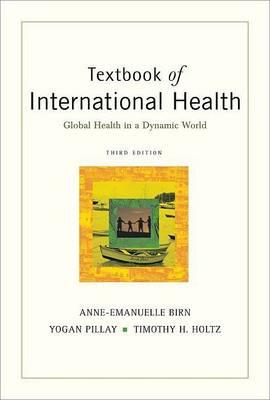 Editors: Anne Emanuelle Birn, Yogan Pillay, and Timothy H. Holtz
Editors: Anne Emanuelle Birn, Yogan Pillay, and Timothy H. Holtz
Publisher: Oxford University Press, 806 pages
Book Review by: Nano Khilnani
This is a unique book. There is probably no other written work out there available to students and professionals that focuses on health problems prevalent on a global scale, and discusses available solutions.
The first two editions of this Textbook of International Health were written by the late Paul F. Basch, who was described by his colleague as “a man of singular purpose.” It has been, and is still acknowledged by students, scholars and others in the field, to be the book on international health. It was, as it still is, commonly known as ‘the Basch book.’ And there are many topics within this field with so much detail and “enough complexity to consume a lifelong career,” as Basch pointed out in his second edition.
In this, what I believe to be a one-of-a-kind compilation of writings on the subject of international health, numerous people around the world in health-related professions and occupations working on or concerned about preventing diseases, share their experiences and suggest ways to improve people’s health and well-being.
International health is a very large issue that affects over seven billion people on this planet. This book shows us there are many types of factors that influence our health. For example, as the authors indicate at the outset, a country’s history, its collective epidemiology (which depends on the collected amount and quality of data available), its environment and its institutions, its economics and its politics, among other influences, determine the average quality of health of its residents.
This book has a wealth of data for decision-making committees. It has three pages each of figures and tables, and almost four pages of boxes. If you want to look for example at figures pertaining tuberculosis mortality and medical interventions, you will find it here. If you want for example to look at tables on the causes and treatment of diabetes (or obesity) according to contrasting approaches to wealth, this is your source for such information.
Do you want to know what the top international health imperatives are? You do not have to go through a hundred or so pages. All you have to do is go on page 55 and look at one single box, in which the top 10 imperatives are listed: charity, missionary work, war relief, philanthropy, diplomacy, economic development, paternalism/colonialism, sharing of expertise (and technology transfer), transnational training, and data collection (including disease surveillance and standardization).
Then if you want to read on a particular health imperative (or a few of them) simply go to the index to get to the page where that topic is written about in the book.
This is a very valuable book, especially to national leaders and policy makers, in terms of preparedness imperatives and plans to deal with health disasters before and after they occur. It goes over past massive life-and-death events, and the international, national, regional and local responses to them. It then discusses alternative, better and more effective means of responding to such tragedies in the future
Civil wars, ecological disasters (such as earthquakes, tsunamis, typhoons and tornadoes, etc.), humanitarian emergencies, refugee populations and their movements, and other events that impact on peoples’ lives and health are covered in this important book. The various ways in which public and private sector organizations, professionals and concerned citizens can deal with them are laid out in this large textbook.
In the course of daily living however, diseases, not large-scale disasters, are the most common causes of death. According to a World Health Organization report, the top 20 causes of about 37.2 million deaths worldwide in 2003 (rounded to the nearest thousand) were the following:
Top 20 Causes of Mortality throughout the World
|
|
All countries |
||
|
Rank |
Cause |
Total deaths |
% of total |
|
1. |
Ischaemic heart disease |
7,208,000 |
12.6% |
|
2. |
Cerebrovascular disease |
5,509,000 |
9.7 |
|
3. |
Lower respiratory infections |
3,884,000 |
6.8 |
|
4. |
HIV-AIDS |
2,777,000 |
4.9 |
|
5. |
Chronic obstructive pulmonary disease |
2,748,000 |
4.8 |
|
6. |
Diarrheal diseases |
1,798,000 |
3.2 |
|
7. |
Tuberculosis |
1,566,000 |
2.7 |
|
8. |
Malaria |
1,272,000 |
2.2 |
|
9. |
Cancer of trachea/bronchus/lung |
1,243,000 |
2.2 |
|
10. |
Road traffic accidents |
1,192,000 |
2.1 |
|
11. |
Childhood Diseases |
1,124,000 |
2.0 |
|
12. |
Other unintentional injuries |
923,000 |
1.6 |
|
13. |
Hypertensive heart disease |
911,000 |
1.6 |
|
14. |
Self-inflicted |
873,000 |
1.5 |
|
15. |
Stomach cancer |
850,000 |
1.5 |
|
16. |
Cirrhosis of the liver |
786,000 |
1.4 |
|
17. |
Nephritis/nephrosis |
677,000 |
1.2 |
|
18. |
Colon/rectum cancer |
622,000 |
1.1 |
|
19. |
Liver cancer |
618,000 |
1.1 |
|
20. |
Measles |
611,000 |
1.1 |
Read more: Top 20 Causes of Mortality Throughout the World — Infoplease.com http://www.infoplease.com/ipa/A0779147.html#ixzz2Hn30Teyd
The situation is different for developed countries, such as the United States. According to the Center for Disease Control (CDC) there were about 1.83 million deaths in 2009 in the U.S. mainly from diseases. Here is the breakdown below:
Number of deaths from leading diseases in U.S. in 2009
- Heart disease: 599,413
- Cancer: 567,628
- Chronic lower respiratory diseases: 137,353
- Stroke (cerebro-vascular diseases): 128,842
- Accidents (unintentional injuries): 118,021
- Alzheimer’s disease: 79,003
- Diabetes: 68,705
- Influenza and Pneumonia: 53,692
- Nephritis, nephrotic syndrome, and nephrosis: 48,935
- Intentional self-harm (suicide): 36,909
You will note that the top two leading causes of U.S. deaths – heart disease and cancer – account for 63.47 percent of the total, or nearly two out of every three deaths.
Anne-Emmanuelle Birn ScD is Canada Research Chair in International Health and Associate Professor at the University of Toronto.
Yogan Pillay PhD is Deputy Director-General for Priority Health Programmes at the National Department of Health in South Africa.
Timothy Holz MD is a medical epidemiologist working in sub-Saharan Africa, Eastern Europe and Asia on the epidemics of tuberculosis and HIV-AIDS.







